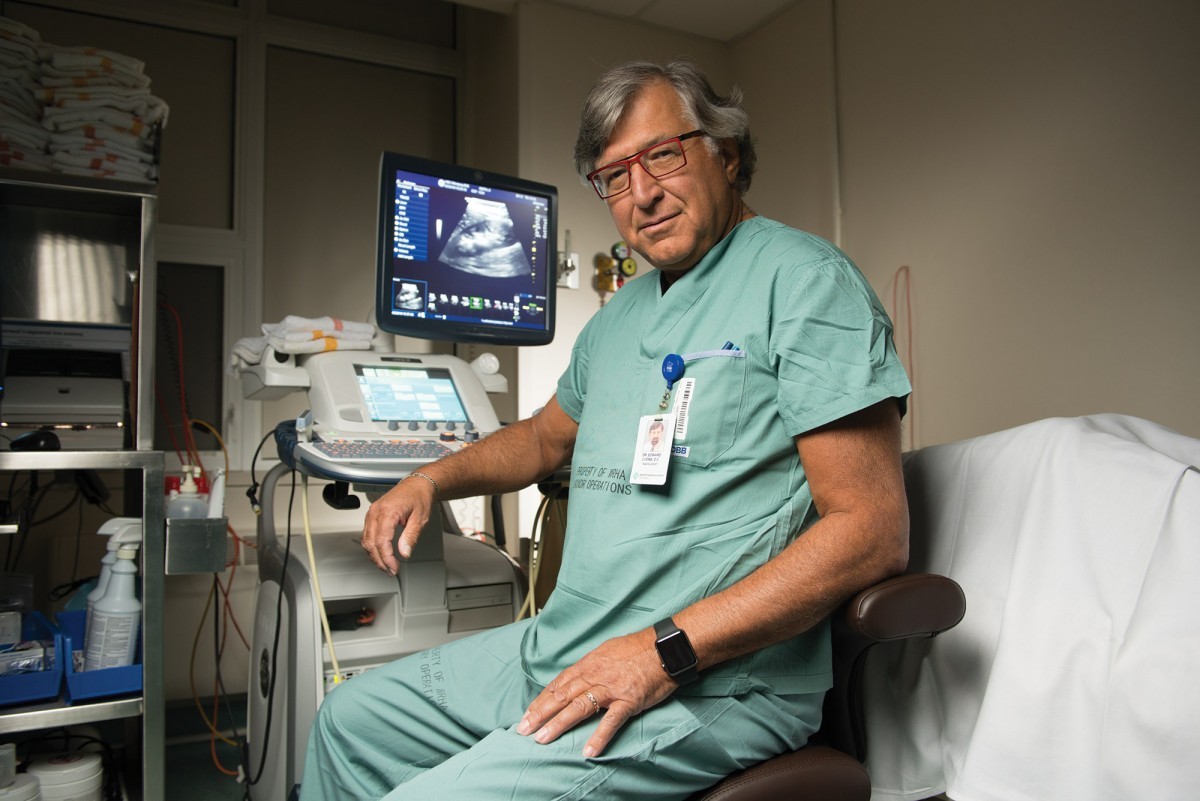Every hour, expectant parents around the world are reassured of the health of their unborn child thanks to one of today’s most common diagnostic tools—the ultrasound—and one of its earliest pioneers, U of M’s Dr. Edward Lyons, OC [BSc/63, BSc(Med)/68, MD/68]. His groundbreaking research helped establish ultrasound as safe for fetuses and mothers, and his findings influenced hospitals across the globe to adopt the technology. For years he worked with manufacturers to enhance ultrasound and evolve it from a machine the size of a refrigerator to a device no larger than a cellphone—portable enough to reach remote locations. (See page 37 for his thoughts about U of M-borne technology.) “People open doors but not everyone walks through. I chose to explore the opportunities that were available to me.”
IN HIS OWN WORDS
In almost 50 years we’ve gone from an image that looked like a snowstorm, to being able to look inside the body with exquisite detail at all the major solid organs, to lifelike 3-D images of fetuses. I didn’t know that [in 1964]. Nobody knew. The 1970s was the onset of the rapid evolution of computers. Medical imaging and the medical applications skyrocketed as computer hardware and software evolved.
In 1978 I published the first color atlas of sectional anatomy, complete with a set of slides for teachers. This was done with the help of the anatomy department and was a compilation of hundreds of body slices in different planes. With the advent of sectional imaging, there was now a need for an annotated anatomical reference guide. Prior to that, anatomists and surgeons dealt only with gross anatomy, visible to the naked eye, and had no need for cross sectional imaging, which allowed for viewing inside the body.
I was a traveller on a stream of new imaging technology that for me was not only fascinating but life and career altering.
People open doors and not everyone walks through, but I chose to explore the opportunities that were available to me.
I always liked technology, especially new technology. I did all kinds of experiments with this technology. In the ’70s we started to look at pregnancy especially the early developing fetus. Of course the big question is: You can see things but are you harming anyone? I did experiments on chicken eggs to see if excessive exposure to ultrasound would result in abnormal chickens. We found no abnormalities, nothing, and there were many studies done. The healthy chickens from the experiments were donated to my wife’s Grade 5 class—a homemade coop and all. They were a big hit with the children.
I was lucky to get into the field at that time. Had I come in 10 years earlier or 20 years later, I would have missed the boat and the chance to do some of the early work, meet and work with other international ultrasound pioneers and in some way, help to influence the field.
I was able to ride the wave of technology and work very closely with international imaging companies. We had a big established ultrasound lab very early on; we were the first lab in Canada doing general ultrasound. Companies were looking to work with labs doing clinical work to test and then highlight their technology at various imaging meetings. Our ultrasound team was more than willing to do that: to be able to use the latest technology to realize better imaging of all organs. This was in return for spending a little more time or doing things slower in the lab. Ultimately, I spent a lot of time lecturing on the new technology I had an opportunity to use. In 1985 we were the first lab to use a newly developed probe that could be placed within a few centimeters of a developing embryo. These images of a 3mm, six-week embryo were mind-blowing.
I loved doing what I was doing. I love medicine. My role model was my father, Dr. Ruvin Lyons, a dedicated obstetrician and community leader. He practiced for 50 years and retired at age 82. He loved medicine and his patients idolized him. And I saw that and it inspired me.
My parents, my wife Harriet, my son Sami, his wife Rose, my daughter Mara, her husband Sheldon, and our four granddaughters also played a major role in supporting and encouraging me throughout my career.
I loved working with new technology. I loved dealing with patients. I loved working with clinicians to solve difficult problems. It was an exciting time and still today I love it just as much.
The future? We still haven’t realized it. As I say in my lectures to first-year Medicine, I show people what the technology used to be, what it is today, and what it could be tomorrow when they have these ultrasound machines in their pockets instead of a stethoscope. Whether they are in a high-tech environment like Winnipeg or a low-tech environment in some rural communities, they should be better able to evaluate their patient’s problems.
The best part of my day is when a clinician calls me and says, “Ted, I have a problem. Can you help me?” And I do what I can do using ultrasound technology to help them out. It’s something I find very rewarding.
My advice to medical students is that medicine is a never-ending journey of listening, learning, practicing and helping. Enjoy your journey. I certainly have. If you can, find a role model and follow his or her path.








Excellent article.
Ted has always been a great and bright individual and I am so happy for him and his family. He was one of my favorite colleges in medical school.
Very interested to learn that he, Bryan Klein and Garry Smith went travelling all around even to Israel!